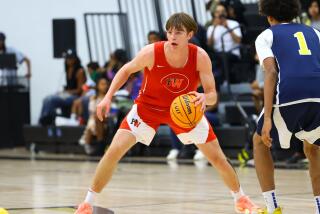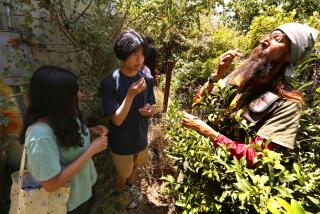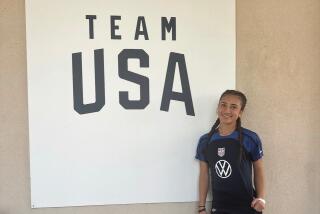The Inclusive Prep School
EAST PALO ALTO — What chance does a bunch of poor minority kids from this rough and ragged community south of San Francisco have of going to college?
About as much chance as a rich white kid from up the road in tony Atherton once had of becoming a basketball star.
The all-too-familiar stereotypes in the two San Francisco Bay Area suburbs had been: White men don’t jump, and black men don’t learn. But those expectations have been turned on their heads at a place called Eastside College Preparatory School.
The tiny, private high school founded four years ago by a kid from Atherton has created an oasis of hope in what had been a desert of low expectations called East Palo Alto, a city of 23,000 on the freeway between San Francisco and San Jose.
Chris Bischof parlayed his love of basketball and a neighborhood tutoring program into a blossoming private high school that sends poor, minority teenagers from East Palo Alto to top colleges across the nation. He did it with the help of a tireless friend from Stanford University, Helen Kim.
A crowning moment for the fledgling school came last spring, when its first graduating class of eight seniors found their mailboxes stuffed with college acceptances. Among the schools the Eastside Eight are attending this fall: Stanford, Mills College, Marymount College and the University of Pennsylvania.
Hundreds of guests squeezed onto campus for graduation. If they weren’t crying, they probably had goose bumps. The achievement was that much of a revelation in a community slowly pulling itself up from a low ebb.
Nearly a quarter-century ago, East Palo Alto’s only public high school was closed to promote integration. Its students have been bused to other public high schools ever since. Eight years ago, the impoverished city suffered more murders per capita than any other in the nation. Even today, nearly three-quarters of its students are poor enough to qualify for free or discounted school meals.
So Eastside is a clear symbol of rebirth, as much as the new housing tracts creeping in among the tired bungalows and the recently opened shopping center.
“They are building a culture at Eastside where kids know school is about working and being serious,” said Josh Edelman, co-director of a program that assists underprivileged students at a nearby public campus, Menlo-Atherton High School. “They have created a culture where it’s cool to be smart. That is a great accomplishment.”
That culture forces hard choices. On Friday nights, Eastside students can’t go home until they have finished all their assignments.
“I am here five or six hours a night,” said Alex Young, a junior, with apparent pride. “Some of my friends say, ‘You gotta be young and have fun,’ and I say back to them, ‘What you do now is going to come back to you later.’ ”
Eastside Prep has blossomed from its initial class of eight freshmen four years ago housed in makeshift, rented classrooms. Adding a grade or two each year, the school now boasts 86 students in grades six through 12, tucked into a small but attractive campus of wooden bungalows surrounding a neat grass quad. Bischof and co-founder Kim plan to expand to 140 students over the next few years.
“We are going to have to see if we can do that and maintain our personal contact and intimacy that is one of our keys,” said Bischof, 30.
In the Bay Area and in educational circles nationwide, such a “boutique” school inevitably gets judged by how many children it reaches. Experts wonder how “portable” the model is.
Eastside’s founders have tried to make the school as egalitarian as possible. They admit students on full scholarships, funded by the school’s ever-growing base of donors. The students, all from local communities, don’t have to be top achievers coming in, as long as they show determination and a desire to go to college. The school expects as many as four times more applicants than openings for next fall’s class of 20 high school freshmen.
Just to the south, in San Jose, the model already has been replicated by a former Eastside English teacher, Greg Lippman. His public charter school, Downtown College Prep, hopes to increase the neighborhood’s paltry college matriculation rate.
Lippman said the formula for success is to combine a high-quality faculty and staff with rigorous standards, small classes and personal attention for students. “The lesson to be learned from Eastside,” Lippman said, “is that college can be a goal for students who aren’t originally headed in that direction.”
Nationally, such high-powered academies were championed by the presidential candidates, Vice President Al Gore and Texas Gov. George W. Bush. In their first debate, Bush lauded the Knowledge Is Power Program academy in Houston. The charter middle school and its twin in New York City have supercharged achievement and test scores among minority students.
The creators of the Knowledge Is Power Program, a pair of Ivy League graduates, now hope to clone the schools at hundreds of locations nationwide, with the help of a $15-million donation from the founders of the Gap clothing stores.
Bischof Came to Know Two Different Worlds
Eastside had its roots in the basketball dreams of a 15-year-old from affluent Atherton. Bischof had been raised amid privilege, and educated at the exclusive Phillips Academy in Andover, Mass.-- alma mater of several Kennedys and of George W. Bush--and later at Crystal Springs Uplands School in the Bay Area.
When he wanted to challenge his burgeoning basketball skills, though, Bischof made a radical leap. He decided to spend his after-school hours in another world, at the recreation center in East Palo Alto. (In Southern California, a journey from Beverly Hills to Watts might be the equivalent.)
Bischof had been raised to be comfortable with other cultures. Although he is light-skinned and identified by others as white, his mother was born in Mexico.
On the basketball floor in East Palo Alto, Bischof had another important quality: He could play. His skills and determination as a hard-charging guard would pay off with the respect and friendship of his teammates, most of whom were black.
He would go on to be high school Player of the Year in San Mateo County. But as graduation drew near, Bischof saw something that shook his still-sheltered sensibilities.
While he prepared for the college years at Stanford that seemed his birthright, he hung out with black teammates who had little inclination, and no assistance, toward attending college. He tried to help one teammate apply to a California State University campus, only to see the young man fail to be admitted. “That really stirred some feelings for me,” Bischof recalled. “I guess ‘rage’ is a good word to describe it. There were these obvious injustices. It would be so apparent to anybody.”
“My friends and teammates were working as hard as I was,” he added, “and they just didn’t have the same opportunities open to them. At 17 years old, it was kind of a shocking reality to me.”
Seared by that experience, Bischof headed off down the road to Stanford. Soon he was taking education classes and venturing again to the far side of U.S. 101 and East Palo Alto.
There, he founded a program that combined basketball and academics. If students would read and study for a couple of hours, Bischof would coach them in basketball for a couple of hours.
Some in the poor community initially were skeptical. They had seen generations of Stanford graduate students step off the luxuriant campus only to turn East Palo Alto into a ghetto for social science research. After their academic work was done, they would pack up and leave town.
Commitment That Went Beyond Tutoring
Bischof has broken the mold. Moving on to graduate studies at Stanford and then to work as a public school teacher, he never left “Shoot for the Stars,” the basketball and tutoring program he had founded in East Palo Alto while still in college.
“Chris has been here for 10 years now,” said Larry Moody, whose son has enrolled at Eastside. “He has proven himself.”
But merely tutoring youngsters left Bischof frustrated. He believed that kids who left his program in East Palo Alto were routinely tracked into low-level classes when they were bused to high school in more affluent nearby Woodside or Atherton.
East Palo Alto’s own high school, Ravenswood, closed in 1976 in a desegregation move. But the idealistic effort to integrate local schools had only succeeded in bringing kids from varying backgrounds together at new campuses. Once there, they often remained divided by race and class, Bischof believed.
Kiazi Malonga still remembers the day about six years ago when his tutor-coach, Bischof, told his charges that he wanted to start a high school. “Even though we knew Chris was a person of his word, we thought, ‘Can this be serious?’ ” Malonga recalled.
In the school’s first year, Bischof and Kim and their eight high school freshmen shared space with other nonprofits. They had to move four times. At one location, their adult-sized students had to cram into kindergarten chairs. Rock bottom came when a vandal smashed up the classroom and stole the school’s only real property, a television set and VCR.
“People would say, ‘Where is your school?’ and we would say, ‘We don’t really have a place’ ” former student Malonga said. “And they would laugh and make fun of us.”
Boosters in the Silicon Valley
So it was like a glossy movie ending when the eight pioneers walked across Eastside’s spanking-new campus in cap and gown last June--every one of them bound for a four-year college. Malonga started classes last month at Stanford, where he hopes to study engineering and teach his own art, Congolese drumming.
Sitting recently in the middle of the 1.6-acre Eastside campus, surveying the shining new $1.7-million gym, Malonga marveled: “I think, ‘Dang, we have come a long way!’ ”
The tremendous wealth of the surrounding Silicon Valley has helped finance the campus. The land and gymnasium construction costs were borne by anonymous donors. Just the other day, representatives of a high-tech firm stopped by, offering to wire not only the school, but also the homes of students, with free high-speed Internet connections. Eastside students have won internships at technology powerhouses like Intuit and Hewlett-Packard. The $1.3-million operating budget comes from donations and grants.
Bischof and Kim have attracted their faculty from academic powerhouses like Caltech, Yale, UC Berkeley and Dartmouth. Stanford grad Coco Ballantyne put off medical school to teach math. Jennifer Foster, a Fulbright scholar from Yale, dropped off the academic escalator and her research in African poetry to teach classes in verbal and mathematics reasoning.
Most of the staff of 20-somethings don’t have children, so they find it easier than most to cope with Eastside’s prolonged class and study hall hours, 8 a.m. to 5 p.m. Often, they work much later.
Students call teachers by first name. They have their home phone numbers, too. “They aren’t really like teachers,” explained sophomore Theron Jones, 15. “They are like friends with a lot of knowledge, who just want to pass it on.”
Stressing Academics Along With Sports
Eastside offers daily math and verbal reasoning sessions, stressing skills the students will need to succeed on standardized tests. The school’s Entrepreneur Program has already helped students start small enterprises to sell vending-machine candy and sweatshirts.
The old basketball imperative has not been forgotten. Last year, the boys team won its second Central Coast Section championship for small schools, and came within one victory of winning the Northern California championship.
The long hours and hard work have overwhelmed a few students, who dropped out or were asked to leave. “If we get to a situation where [students] say they don’t want to be here, we say, ‘OK, life is full of choices, important choices, and this is one of them,’ ” said Kim. As she spoke, she wheeled a school van around the streets of East Palo Alto after 9:30 p.m. Riding with her were half a dozen students who had stayed late to study.
Kim and Bischof seem to lead an almost monastic existence, cloistered at the school late at night and on weekends. Bischof lives at the back of the campus, in a small, gray bungalow.
But their long hours make Bischof or Kim always available--to unlock the computer lab, a classroom or the gym.
Only once in the last four years has Bischof had a real break: a long weekend in Monterey. One friend quipped that Bischof seems like a “21st century monk.”
But he insists that being at Eastside is not like real work. “It’s really a community here, and I love it. The atmosphere is so positive,” Bischof said. “I become more and more invigorated every day.”
More to Read
Sign up for Essential California
The most important California stories and recommendations in your inbox every morning.
You may occasionally receive promotional content from the Los Angeles Times.










